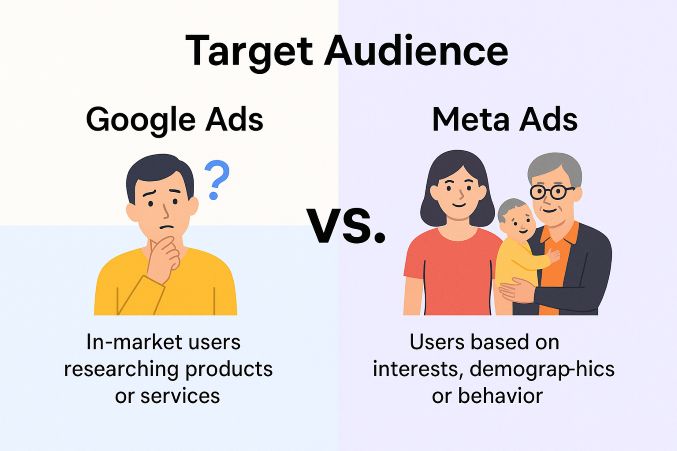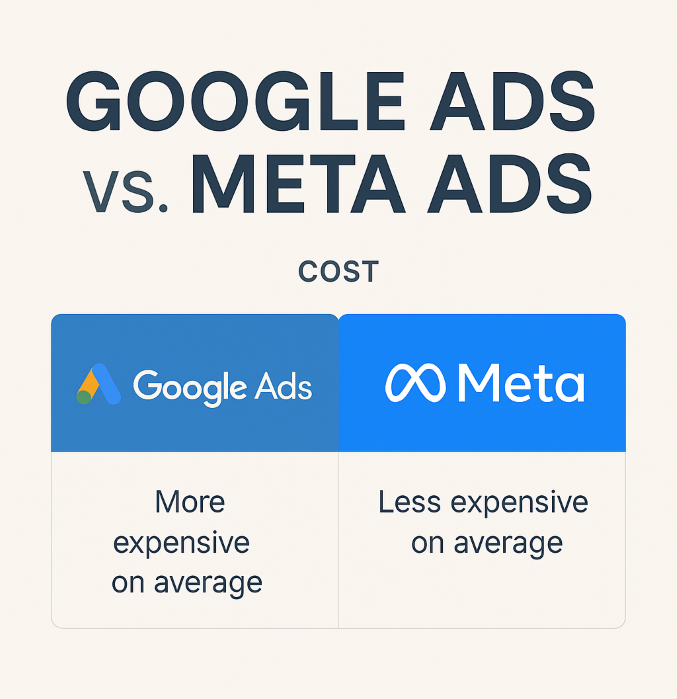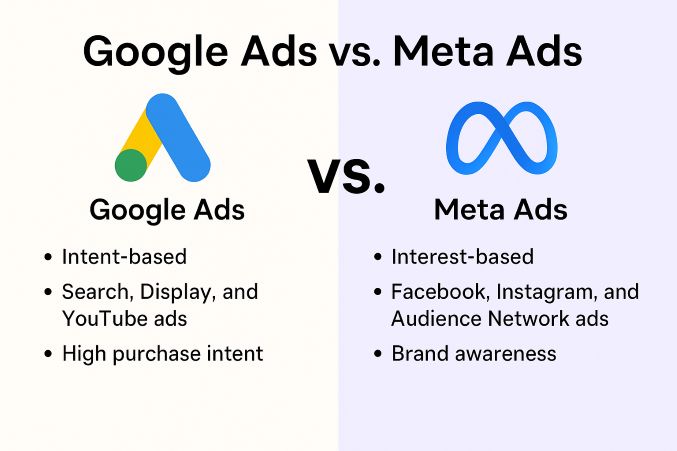Google Ads vs. Meta Ads: What Platform Provides More ROI to Different Businesses?
1. Introduction: The Paid Advertising Dilemma
In this competitive era of e-commerce, all kinds of and sizes of businesses must make a life-changing choice: where will it place its advertisement dollars so as to gain maximum return on investment (ROI)? Two heavy hitters dominating the area for paid ads are Google Ads and Meta Ads (Facebook Ads). But the majority of marketers and business owners get confused and frustrated while choosing between the two platforms. Most of the times, this confusion will lead to misoptimized campaigns, wasted budgets, and missed opportunities to reach the right people at the right moment. Incorrect decision means not only throwing money, but wasting important time which you might have invested otherwise in the development of your brand or your business. Piece of news. After you complete reading this blog, you should be clear regarding the advantages and disadvantages of using each platform and accordingly be spending your advertisement funds in the region that will derive maximum ROI suitable to your company needs.
2. Brief Overview: Google Ads versus Meta Ads
Google Ads is the biggest pay-per-click advertising network worldwide, offering businesses a chance to promote on Google's search engine results pages (SERPs), YouTube, Gmail, and billions of web pages with the Google Display Network. The biggest strength of Google Ads is that it can leverage intent. When a person types a search query in Google, they're deliberately seeking an answer, product, or service - i.e., they're extremely motivated leads. This platform performs extremely well in connecting advertisers to action-taking customers.
On the other hand, Meta Ads comprise Facebook, Instagram, Messenger, and Audience Network advertisements. As opposed to Google, Meta Ads are primarily interest and behavior-targeted. Ads appear as individuals scroll through their social feed, view videos, or message with friends and content. In these situations, individuals are not necessarily looking for something specific but are open to discovering new brands, products, or ideas based on their interests, demographics, and online behavior. This makes Meta Ads particularly well-suited for establishing a brand, generating awareness, and nurturing potential customers over time.
The fundamental difference between these two platforms is intent-based versus interest-based advertising: Google Ads targets users who have a clear intent to buy or act, while Meta Ads target users based on their interests and behaviors, typically before they realize they need a product or service.

3. Audience Targeting: Who Each Platform Reaches Better
Targeting-wise, understanding the mind of your potential customers on each platform is very crucial.
Google Ads aims at "active searchers" - those users who have an active issue or need and are actively seeking solutions. These users are in either the "decision" or "purchase" phase of the buying process. For example, a person searching for "best running shoes for flat feet" is highly engaged and likely to purchase soon. Google Ads acquires such high-intent traffic by advertising at the moment when individuals are looking for comparable keywords, hence making it a wonderful platform for businesses interested in understanding demand at the moment when it is established.
Meta Ads, however, reaches "passive scrollers" - shoppers who are scrolling through their social feeds without having any urgent need to buy. Such customers are likely in the "awareness" or "consideration" stages of the buying process. They will see an ad for a stylish new coat while browsing Instagram and comment, "That's interesting," without actually having searched for it themselves. Meta's powerful demographic and interest-based targeting allows businesses to reach these users and win them over with engaging content until they're ready to convert.
Understand this difference and you can align your ad strategy with customer psychology and buying habits, so that your ads are more relevant and convert better.

4. Ad Formats and Creative Freedom: Which Platform Wins?
Google Ads and Meta Ads each offer various ad formats, though they differ quite a lot when it comes to creative freedom and the opportunity to tell a story.
Google Ads offers various formats:
Search Ads: Text ads that appear along with search results, focusing on short, concise messaging and calls to action.
Display Ads: Image or banner ads placed on the Google Display Network across millions of websites, best suited for brand awareness.
YouTube Ads: Video ads that can be shown before, during, or after YouTube video, offering dynamic storytelling potential.
Google Ads is more comfortable selling direct response advertising - advertising that will bring direct action, such as clicks, calls, or purchases. The ad will be straightforward and based on resolving a user's problem quickly.
Meta Ads performs best with visual storytelling and emotional engagement, from:
Reels Ads: Short, engaging video ads designed for mobile viewing, best for instant impression.
Story Ads: Full-screen vertical native ads for the user's social experience, perfect for authentic storytelling.
Feed Ads: Visual or video ads in the main social feed, mixing with organic content.
Carousel Ads: Gallery of images or videos that users can swipe through, best for showcasing a range of products or features.
Meta's formats encourage creativity, emotional connection, and brand building, allowing advertisers to share stories that really resonate with their users.

5. Cost Comparison: Which Platform is Less Expensive (and Why That's Deceptive)
Meta Ads will appear less costly on the surface due to lower average CPC and CPM at first sight. For example, you might spend 0.50to0.50to2 per click on Meta, but 1to1to50 on Google Ads, depending on competition and your niche.
But expense alone is a misleading metric in measuring ROI. Lower-cost clicks don't necessarily translate to profitable sales. Google Ads clicks are normally driven by users of higher purchase intent, resulting in higher conversion and customer lifetime value. On Meta, while clicks are less costly, traffic can be less qualified and require more nurturing and follow-up to convert.
Additionally, the cost-effectiveness of the two platforms also depends on your niche, campaign objectives, and ad optimization. A well-optimized Meta campaign to the proper audience may outperform Google Ads in some cases, especially for impulse purchasing and brand awareness.
6. Conversion Behavior: Which Platform Brings Higher-Intent Buyers?
It is important to understand how users behave on both platforms to predict conversion outcomes.
On Google Ads, users typically want instant answers. They type in queries like "emergency plumber near me" or "buy noise-cancelling headphones," which show that they are ready to act. This means conversions often take place earlier, with stronger intent and shorter shopping cycles. Google Ads is ideal for companies that want to capitalize on demand at the moment of searching and convert consumers quickly.
On Meta Ads, conversions are more likely to happen due to impulse discovery or interest-building incrementally. Users might see a good ad for a new skincare product while casually surfing and buy later, or after multiple exposures. This longer buying process makes Meta Ads best suited for lead nurturing, building brand affinity, and repeat buys over time.
This contrast highlights the psychological process that consumers go through: Google Ads intercepts users on intent time, while Meta Ads plant a future interest and purchase.
7. Best Platform for Different Types of Businesses (With Examples)
Below is a brief overview of which platform is likely to work best for various types of businesses, with examples of how they work:
Business Type\tBest Platform (Primary)\tWhy/Example
Service Businesses Google AdsDoctors, attorneys, home handyman services thrive in engaging users actively searching for services. Example: Local dentist gets new patients via Google Search Ads for "emergency dental care near me."
E-commerce Brands Meta AdsFashion, beauty, and lifestyle brands use Meta's visual content to achieve brand recognition and impulse purchases. Example: Fashion brand leverages Instagram Reels and Carousel Ads to showcase new collections.
Local Businesses
Both (Depends on Goals)
Google Ads captures emergency local searches ("pizza delivery near me"), whereas Meta builds community awareness and loyalty through hyper-local targeting. Example: A coffee shop uses Google for immediate orders and Meta for event promotion.
SaaS/Tech Products
Google first, Meta for retargeting
Google Ads captures high-intent searches ("best project management software"), while Meta creates leads with engaging content and retargeting ads. Example: A SaaS company uses Google Ads to generate signups and Meta Ads to retarget visitors with demos.
8. Real-World Case Studies: Winning with Google Ads vs. Meta Ads
Google Ads Success Story: A law firm specializing in personal injury had Google Search Ads for terms like "car accident lawyer near me." Within weeks, they saw a 40% increase in qualified leads, with the majority of clients booking consultations straight from the ads. The searchers' intent resulted in high intent, and that translated to instant business growth.
Meta Ads Success Story: A new startup fashion brand launched a Meta campaign using Instagram Story Ads and Carousel Ads to advertise their new green clothing line. The campaign gained over 10,000 new followers, increased website traffic by 60%, and increased sales by 25% in two months, primarily on impulse purchases and social sharing.
These are some examples of how each platform can produce impressive outcomes when it's used for business goals and consumer behavior.
9. When and Why You Should Use Both Platforms
When both Google Ads and Meta Ads are used together, it is a strong omnichannel marketing campaign. With this, you engage customers across several touchpoints and build brand recall, trust, and ultimately drive conversions.
For example, you can capture high-intent search traffic on Google Ads and retarget those visitors on Facebook and Instagram with engaging creatives to build and close the sale. This multi-step process keeps you from losing potential buyers who are not ready to buy now but will convert if shown multiple times.
Further, consolidating platforms allows you to risk-diversify, optimize budgets based on performance, and create an integrated customer experience across discovery, consideration, and purchase.
10. Final Verdict: How to Decide Based on Your Business Objectives
As you decide between Google Ads and Meta Ads, consider these significant factors:
Budget: Google Ads generally requires a larger budget for competitive keywords, while Meta Ads can be more ideal for smaller budgets and building brand name.
Target Audience Behavior: Is your product actively searched for, or do users happen upon it through social media?
Type of Product/Service: High-consideration products and high-urgency services fare better on Google, while aesthetic products that are impulse-buyable work better on Meta.
Short-Term vs. Long-Term Growth: When you need immediate sales, Google Ads typically are the best option. For long-term brand exposure and lead nurturing, Meta Ads are better.
Data and Analytics: Harness data from both platforms to consistently refine your approach and generate top ROI.
Eventually, the greatest solution is more often than not a tailored blend of both platforms, operating within your unique business requirements and consumer journey.
11. Conclusion + Call to Action
Selecting the appropriate ad platform is a strategic move that can either make or break your marketing campaign. It's not a matter of going with what's trending or your personal whims but knowing your audience, product, and objective. By wisely deciding where to put your ad money-whether Google Ads, Meta Ads, or both-you position your company for long-term growth and better ROI.
Ready to elevate your advertising to the next level?
Leave your questions or anecdotes in the comments below, or contact us directly for a one-on-one consultation on how to maximize your ad campaigns for greatest reach. Let's collaborate to make your marketing budget work smarter, not harder!


Comments
No Comments To Display